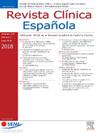Factores asociados con el uso de inhibidores del cotransportador de sodio-glucosa 2 (SGLT2) tras un episodio de insuficiencia cardiaca aguda e impacto pronóstico
IF 1.7
4区 医学
Q2 MEDICINE, GENERAL & INTERNAL
引用次数: 0
Abstract
Objectives
To analyze the factors associated with the use of sodium-glucose cotransporter 2 inhibitors (SGLT2i) and the association between use SGLT2i and post discharge adverse clinical endpoints (composite of 30-day visit to emergency department or acute heart failure [AHF] readmission or death) and 1-year mortality.
Methods
We included all patients diagnosed with AHF in 40 Spanish emergency departments (ED) in November-December 2022 with available data on chronic treatment and at discharge and grouped them according to whether they received SGLT2i at discharge. Treatment with SGLT2i was categorized in never user, prior use and initiation during decompensation. In multivariable models adjusted for 31 independent variables, we investigated factors associated with SGLT2i use at discharge and with new initiation of SGLT2i treatment at discharge, and the relationship between SGLT2i treatment and 30-day adverse events and 1-year mortality.
Results
3,554 patients were included (median age: 85 years, 56% women, 71% hospitalized): 495 (13.9%) were already receiving SGLT2i before decompensation and 733 (20.6%) were discharged with SGLT2i. The use of SGLT2i at discharge was directly associated with prior SGLT2i treatment, diabetes mellitus, hospitalization, and discharge prescription of other drugs recommended for heart failure, and inversely with previous episodes of AHF and dementia. Initiation of SGLT2i during decompensation was inversely associated with these factors and also inversely associated with chronic renal failure. Treatment with SGLT2i at discharge was associated with a lower risk of adverse events at 30 days (adjusted HR: 0.80; 95% CI: 0.65-0.99) and death at 1 year (0.78; 0.63-0.96). These beneficial effects were also observed when SGLT2i was initiated during decompensation (0.65; 0.49-0.87 and 0.71; 0.54-0.93, respectively), and the reduction in adverse events at 30 days was even better in new-onset cases (interaction p: 0.02).
Conclusion
The use of SGLT2i after an AHF episode is low, is higher in patients who were hospitalized, and is associated with fewer 30-day adverse events and deaths at 1 year compared with patients not receiving SGLT2i. Patients who initiate SGLT2i during decompensation have an even greater decrease in 30-day adverse events than patients on chronic therapy.
急性心力衰竭发作后使用钠-葡萄糖共转运抑制剂(SGLT2)的相关因素和预后影响
目的分析与钠-葡萄糖共转运蛋白2抑制剂(SGLT2i)使用相关的因素,以及使用SGLT2i与出院后不良临床终点(30天急诊科就诊或急性心力衰竭[AHF]再入院或死亡)和1年死亡率之间的关系。方法纳入西班牙40个急诊科(ED)于2022年11月至12月诊断为AHF的所有患者,并提供慢性治疗和出院时的可用数据,并根据出院时是否接受SGLT2i进行分组。SGLT2i治疗分为从未使用过、曾经使用过和在失代偿期间开始使用。在调整了31个自变量的多变量模型中,我们研究了与出院时SGLT2i使用和出院时新开始SGLT2i治疗相关的因素,以及SGLT2i治疗与30天不良事件和1年死亡率之间的关系。结果共纳入3554例患者(中位年龄:85岁,56%为女性,71%住院),495例(13.9%)患者在失代偿前已接受SGLT2i治疗,733例(20.6%)患者出院时已接受SGLT2i治疗。出院时SGLT2i的使用与既往SGLT2i治疗、糖尿病、住院和出院时推荐的其他心力衰竭药物处方直接相关,与既往AHF和痴呆发作呈负相关。失代偿期间SGLT2i的启动与这些因素呈负相关,也与慢性肾功能衰竭呈负相关。出院时使用SGLT2i治疗与30天不良事件的风险较低相关(调整后HR: 0.80;95% CI: 0.65-0.99)和1年死亡(0.78;0.63 - -0.96)。当失代偿期间启动SGLT2i时,也观察到这些有益效果(0.65;0.49-0.87和0.71;分别为0.54-0.93),在新发病例中,30天不良事件的减少甚至更好(相互作用p: 0.02)。结论:AHF发作后SGLT2i的使用率较低,住院患者的SGLT2i使用率较高,与未接受SGLT2i治疗的患者相比,1年内30天不良事件和死亡发生率较低。在失代偿期间启动SGLT2i治疗的患者比接受慢性治疗的患者在30天内不良事件的减少幅度更大。
本文章由计算机程序翻译,如有差异,请以英文原文为准。
求助全文
约1分钟内获得全文
求助全文
来源期刊

Revista clinica espanola
医学-医学:内科
CiteScore
4.40
自引率
6.90%
发文量
73
审稿时长
28 days
期刊介绍:
Revista Clínica Española published its first issue in 1940 and is the body of expression of the Spanish Society of Internal Medicine (SEMI).
The journal fully endorses the goals of updating knowledge and facilitating the acquisition of key developments in internal medicine applied to clinical practice. Revista Clínica Española is subject to a thorough double blind review of the received articles written in Spanish or English. Nine issues are published each year, including mostly originals, reviews and consensus documents.
 求助内容:
求助内容: 应助结果提醒方式:
应助结果提醒方式:


